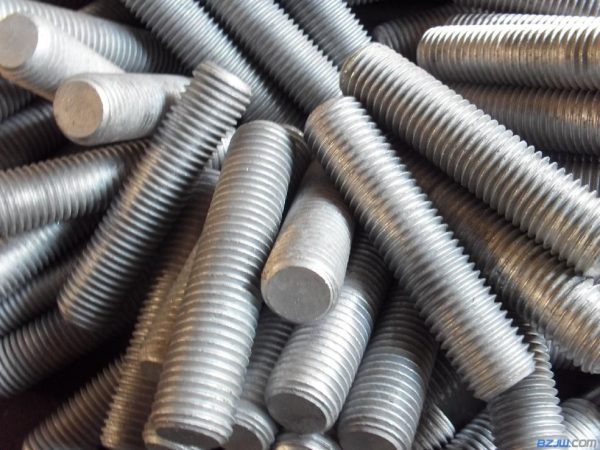Our Location
Hot-dip galvanizing(HDG) is the process of dipping fabricated steel into a kettle or vat containing molten zinc, as defined by the American Galvanizers Association.
This technique effectively safeguards metal against corrosion, particularly steel, and other rust-resistant metals. Coating the metal with molten zinc creates a protective barrier that prevents any moisture from coming into contact with the metal, effectively preventing rust formation.


Hot-dip galvanization begins with meticulously cleaning the fastener surface to eliminate dirt, grease, or oil. Rust and scale are removed by soaking in either heated sulfuric acid or hydrochloric acid, followed by a thorough rinse with water.
Once cleaned, the parts are submerged in a flux tank containing an aqueous zinc ammonium chloride solution. This process eliminates oxides and stops further oxide formation while encouraging zinc bonding to the steel surface.
The galvanizing process involves immersing the parts entirely in a molten zinc bath, with a temperature range of 460°C to 525°C and a minimum purity of 98%. After withdrawal from the zinc, the excess is removed while still in liquid form. The pieces are then cooled with either air or water until the zinc solidifies and can be handled.
The final step is inspection. Enze’s production facilities are certified with ISO 9001. To ensure compliance with governing specifications, we take several precautions. Additionally, full traceability to the original manufacturing lot number is available.

Hot dip galvanizing is a less expensive option compared to other coating applications. Painting steelwork can be highly labor-intensive, whereas hot dip galvanizing is relatively low. There is also very low wastage in galvanizing compared to other processes.
It is crucial to protect steel from corrosion when used in projects exposed to harsh environments and atmospheric conditions. Large construction projects often require a lifespan of 70-100 years, making it necessary to use durable, long-lasting corrosion protection methods. Hot-dip galvanizing provides steel barrier, cathodic, and zinc patina corrosion protection.
Like other coatings, hot-dip galvanizing acts as a barrier between the steel and the environment, providing essential protection. The zinc coating forms tightly bonded intermetallic layers with the base steel, making damaging it difficult. Galvanizing also provides cathodic protection, where the zinc sacrifices itself to protect the underlying steel. The surrounding zinc will resist steel corrosion even if the coating is scratched.
Unlike painted systems, hot dip galvanizing ensures all steel parts are coated. The zinc coats the inside and outside, as well as awkward corners and narrow gaps, ordinarily impossible to protect in any other way.
Steel that has been hot-dip galvanized (HDG) is a versatile and readily available material. Galvanizers are throughout China. Thanks to the factory-controlled process, various shapes and sizes of steel can be hot-dip galvanized at any time, regardless of the weather. Additionally, zinc solidifies quickly upon withdrawal from the bath, meaning schedules can be tight without any delays for curing. Furthermore, HDG steel can be stored outside without compromising the coating’s integrity until it is ready to be used.
Uniform protection and complete coverage are additional benefits of hot-dip galvanizing. The zinc coating grows perpendicular to the steel, ensuring that corners and edges have the same thickness as flat surfaces. The total immersion process also guarantees that hollow and tubular structures are coated and protected inside and out. This complete and uniform coverage means that corrosion has no easy targets to attack.
The hot dip galvanizing process can quickly apply a complete protective coating to steel, including preparation by acid pickling. In contrast, an alternative paint system may require over a week, including drying time.
After hot dip galvanization, steel can be erected immediately without needing touch-ups or additional processes, reducing site times.
Inspecting hot dip galvanized steel is simple and can be done quickly with an electronic probe. The thickness of the zinc can be checked according to BS EN ISO 1461.

It is Zinc.
Zinc plays a crucial role in galvanizing, which involves coating steel or iron with a protective layer. This widely used method helps to prevent corrosion by creating a barrier that stops the metal from oxidizing.
Various factors affect the appearance of galvanized finishes on steel. The chemical composition of steel during the manufacturing process plays a crucial role. Specifically, phosphorous and silicon are significant contributors to the finished appearance. When the steel reacts with zinc, it can result in thicker coatings, uneven surfaces with striations, or even delamination in extreme cases. It can lead to dull layers instead of the desired bright, shiny finish.
“Double dipping” refers to dipping an article that is larger than the dimensions of the bath it’s being dipped in. It can happen in terms of length or width. After the article is removed from the bath, it’s flipped, and the remaining uncoated area is dipped back into the molten zinc to ensure complete coverage.
Zinc plating involves coating a material with a layer of pure zinc between 5 and 30 µm thick. This coating is applied using electricity.
On the other hand, hot-dip galvanizing involves immersing the primary material into molten zinc heated to 450-460 C. The resulting coating is much thicker, ranging from 55 to 200 µm. This method of corrosion protection involves alloying zinc from the molten mass with iron from the primary material. Layers are created, with the percentage of zinc increasing towards the material’s surface, reaching 100%. The main advantage of this method of corrosion protection is better adhesion of the zinc coating, resulting in longer-lasting corrosion protection.
Before hot-dip galvanizing, the underlying material must be free of paint or zinc. Rust removal is not required as it is part of the process.

